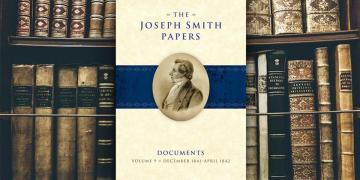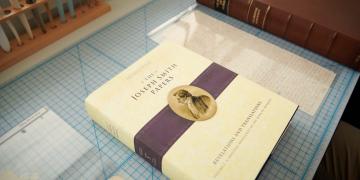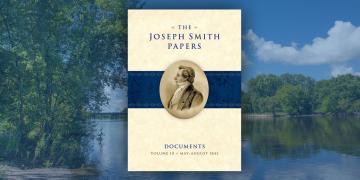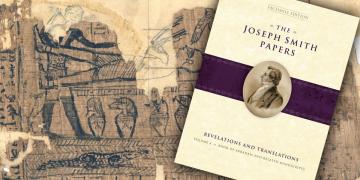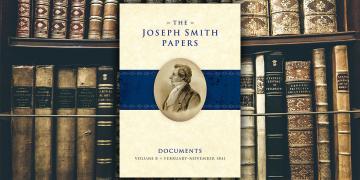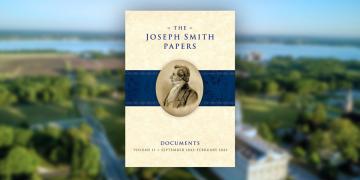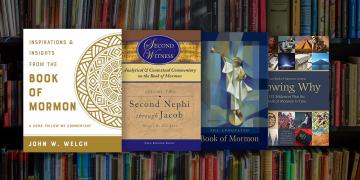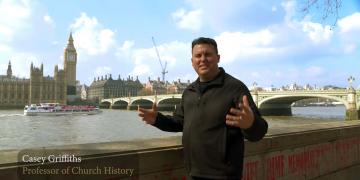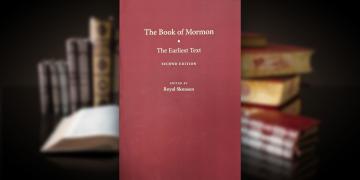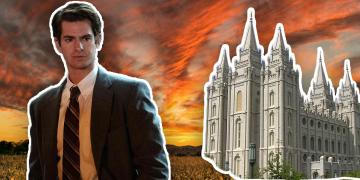You are here
Book of Mormon Central is in the process of migrating to our new Scripture Central website.
We ask for your patience during this transition. Over the coming weeks, all pages of bookofmormoncentral.org will be redirected to their corresponding page on scripturecentral.org, resulting in minimal disruption.
A new volume of the Joseph Smith Papers Project has now been published, featuring “ninety-eight documents including Joseph Smith’s correspondence, accounts of his discourses, and petitions seeking redress from the federal government. The volume also features pay orders, militia commands, and an interview with a newspaper editor from Pittsburgh, Pennsylvania.”
The new volume is the thirteenth in the Documents series of the project and covers Joseph Smith’s papers ranging from August–December 1843. This new volume “details [the] momentous events [of this time] as well as Joseph Smith’s ongoing efforts to lead, teach, and minister to the growing number of Latter-day Saints in the United States and abroad.” As a news release relating to the new volume explains,
During the months covered in this volume, Nauvoo, Illinois, was humming with activity as migrants continued to pour into the city and surrounding towns from the eastern United States and Great Britain. Civic and church leaders worked to develop Nauvoo’s infrastructure, and the city grew closer to becoming the “corner-stone of Zion.” As the Latter-day Saints constructed the Nauvoo temple on a bluff overlooking the Mississippi River, Smith elucidated key religious principles associated with the temple, such as priesthood, election, and the sealing power, in public discourses and private meetings.
Documents pertaining to Joseph Smith’s evolving political views feature prominently in this volume. This includes letters Joseph wrote to John C. Calhoun and received from Henry Clay on, respectively, November 4 and November 15, 1843. The letter to Calhoun was one of several written to various presidential candidates asking them what their policies would be toward members of The Church of Jesus Christ of Latter-day Saints should they be elected president. “What will be your rule of action relative to us, as a people,” Joseph asked Calhoun, “should fortune favor your ascension to the Chief Magistracy?” (Joseph asked something similar of Clay in a letter also sent on November 4, 1843.) Calhoun responded in a letter also featured in the new volume dated December 2, 1843.
Besides these texts, the new volume features the political tract General Joseph Smith’s Appeal to the Green Mountain Boys, composed in later November to early December 1843. Ghostwritten by William W. Phelps but ultimately approved by Joseph, the pamphlet sought to appeal to the patriotism of Vermont’s citizens to assist the Latter-day Saints in redressing their grievances against the state of Missouri.
But the new volume covers more than just documents pertaining to Joseph Smith’s politics. It also features transcripts of important discourses and revelations Joseph received and gave during this time. For instance, on August 13, 1843 Joseph gave a funeral sermon for Elias Higbee. “There is a thought more dreadful than that of total annihilation,” said Joseph on that occasion. “That is the thought that we shall never again meet with those we loved here on earth” (spelling standardized). Worse than no afterlife in Joseph’s thinking is an afterlife where we do not enjoy the relationships with family and friends that we had on earth. On November 25, 1843, Joseph received a revelation for John E. Page that was never canonized. The text of this revelation is featured in the new volume.
Let
Letmy servant John E. Page take his departure speedily from the City of Boston, and go directly to the city of Washington, and there labor diligintly in proclaiming my gospel to the inhabitants thereof, and if he is humble and faithful, lo! I will be with him, and will give him the hearts of the people that he may do them good, and build up a church unto my name in that City.
Hidden gems such as these afford us important glimpses into Joseph Smith’s thinking and his prophetic teachings on a variety of topics that might go otherwise unnoticed.
Other interesting items in this volume include David Nye White’s August 29, 1843 account of Joseph Smith’s First Vision (one of the few contemporary reports of that event) and Glen Hardeman’s December 19, 1843 letter to Joseph apparently attempting to hoax or spoof the Prophet with phony “Egyptian hieroglyphics.” According to the volume editors, there is “no known response” from Joseph to this inquiry.

Detail from Glen Hardeman’s December 19, 1843, letter to Joseph Smith with purported “Egyptian hieroglyphics.” According to JSP editors, Hardeman was probably attempting to hoax or trick Joseph by asking the Prophet for a translation of these fabricated characters. No known translation or other response to this hoax from Joseph is extant.
This period (August–December 1843) also saw the continued gradual unfolding of temple ordinances and related teachings and practices. As the volume editors explain,
In private, [Joseph] Smith continued to administer to a select group of church members sacred rituals, or ordinances, intended for the temple then under construction. . . . Smith introduced another important ordinance to the council in September 1843. On 28 September, Joseph and his wife Emma Smith were “anointed & ordd. [ordained] to the highest and holiest order of the priesthood.” Other members of the council eventually received the same ordinance, which Wilford Woodruff referred to in his journal as a “Second Anointing.” Beginning in October, other women received the ordinance and began regularly attending meetings of the council. In addition to participating in sacred rituals, the growing number of church members invited to attend these meetings prayed together and received instruction from Joseph Smith about teachings and doctrines associated with the temple. (Hyperlink added, footnotes removed.)
It was also during this period that Joseph was sealed or married to his final two plural wives: nineteen-year-old Malissa Lott and fifty-six-year-old widow Fanny Young. “While most Latter-day Saints remained unaware that Smith and others engaged in the practice,” the editors write, “the church leader quietly shared his teachings on the doctrine during the second half of 1843.” Some of Joseph’s papers “created during fall 1843 allude to the ways that church members discussed the practice of plural marriage or how Joseph Smith regulated it.” Despite our remaining gaps in the documentary record pertaining to this topic, what is abundantly clear is that this period was a tumultuous one for Joseph as his relationship with once-trusted allies such as William Law deteriorated over the polarizing practice of plural marriage. “Law’s opposition to the practice of plural marriage was apparently a poorly kept secret in late 1843, and it eventually became one of the central tenets of his vociferous opposition to Smith.”
These are only a few examples of the scores of interesting and important texts published in the new volume of the Documents series of the Joseph Smith Papers. “The documents featured in this volume of the Joseph Smith Papers,” the editors of the volume explain, “underscore the growth and relative prosperity of the Latter-day Saint community centered in Nauvoo, as well as the growing religious, political, and social influence of the church and its members in western Illinois and abroad.” With the new publication of Volume 13 of the Documents series the Joseph Smith Papers Project continues to set a high standard in documentary editing and presentation. Interested students and scholars of Latter-day Saint history, as well as Latter-day Saint lay readers simply interested in the early history of the Restoration, will be greatly benefitted from this new publication.
Subscribe
Get the latest updates on Book of Mormon topics and research for free




